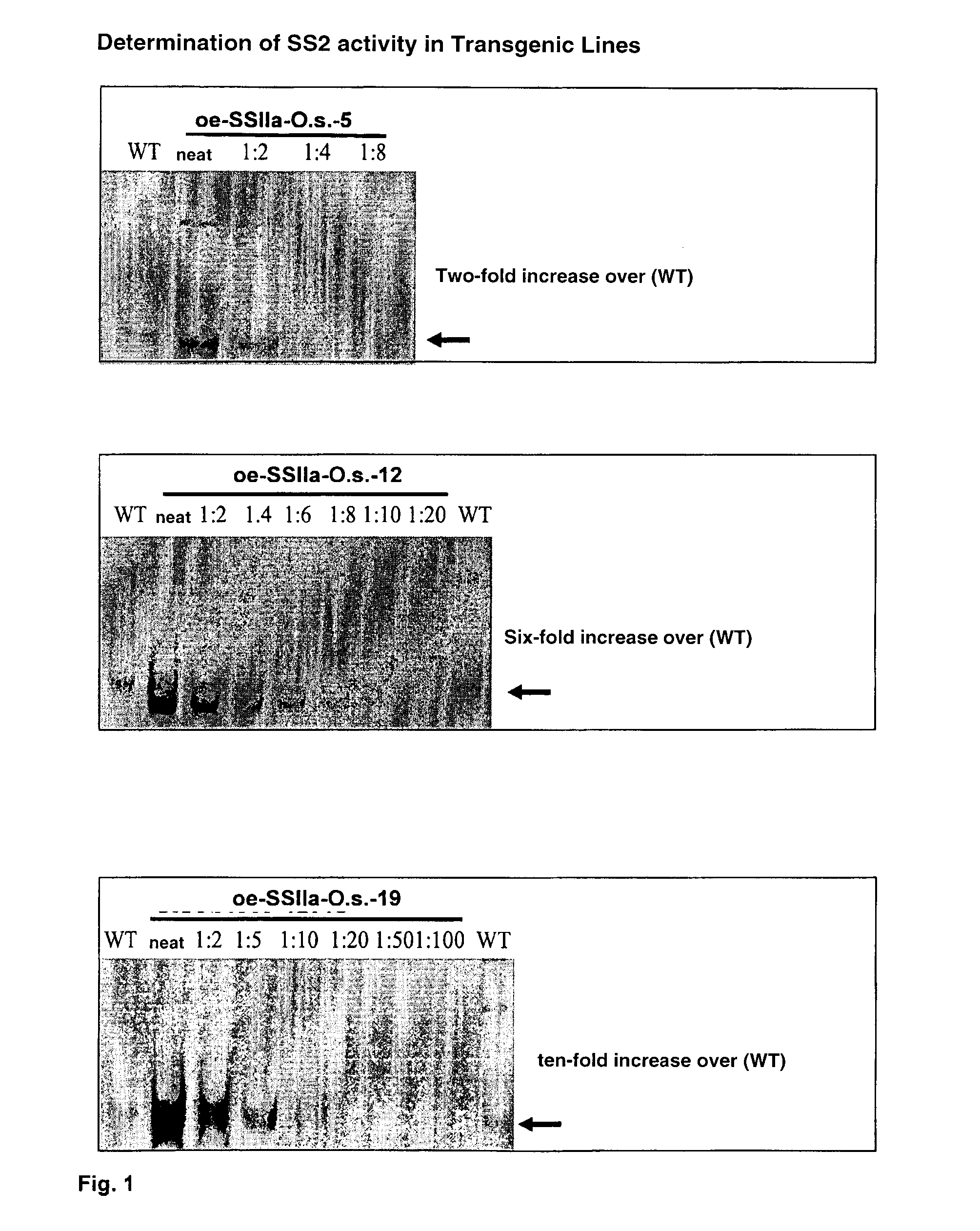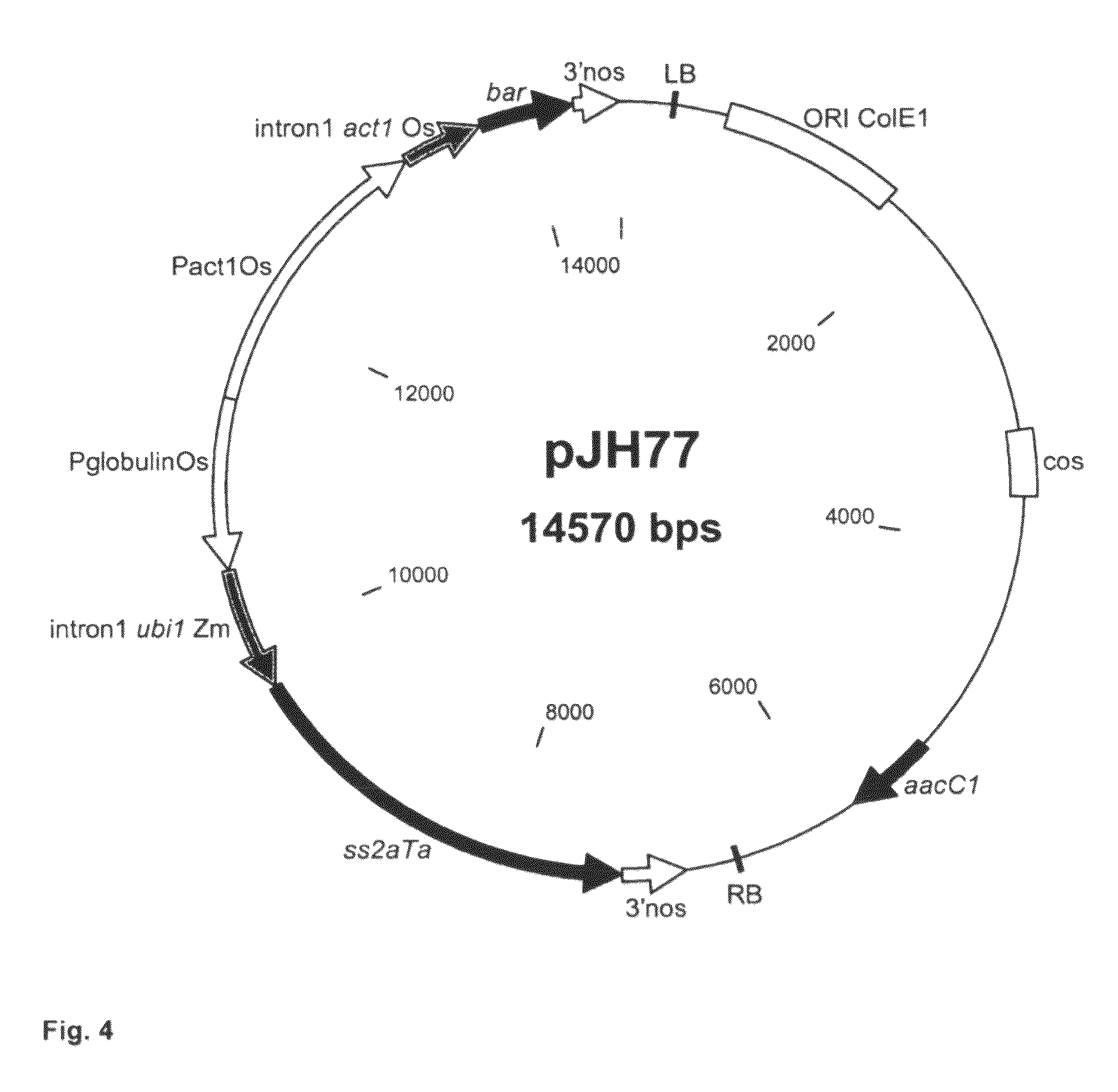[0078]Plant cells according to the invention or plants according to the invention can therefore also be produced by introduction of a foreign nucleic acid molecule which leads to the increase in the activity of a protein having the activity of a glucan-water dikinase in a mutant cell or a mutant which already has an increased activity of a protein having the activity of a starch synthase II. Plant cells according to the invention or plants according to the invention can also be produced by introduction of a foreign nucleic acid molecule which leads to the increase in the activity of a protein having the activity of a starch synthase II into a mutant cell or a mutant which already has an increased activity of a protein having the activity of a glucan-water dikinase. Plant cells according to the invention or plants according to the invention can also be produced by crossing a mutant, in which the activity of a protein having the activity of a glucan-water dikinase is increased, with a plant which on account of the introduction of a foreign nucleic acid molecule has an increased activity of a protein having the activity of a starch synthase II. Likewise, it is possible to produce plant cells according to the invention or plants according to the invention by crossing a mutant, in which the activity of a protein having the activity of a starch synthase II is increased, with a plant which on account of the introduction of a foreign nucleic acid molecule has an increased activity of a protein having the activity of a glucan-water dikinase.
[0079]Plants according to the invention can also be produced by crossing a mutant, in which the activity of a protein having the activity of a starch synthase II is increased, with a mutant in which the activity of a protein having the activity of a glucan-water dikinase is increased.
[0101]Starch which is synthesized from plant cells according to the invention or from plants according to the invention is distinguished, in comparison to starch isolated from corresponding wild-type plant cells which are not genetically modified or in comparison to starch isolated from corresponding wild-type plants which are not genetically modified, in particular in that it has an increased hot water swelling power.
[0166]Intron sequences between the promoter and the encoding region can also be present. Intron sequences of this type can lead to stability of expression and to increased expression in plants (Callis et al., 1987 Genes Devel. 1, 1183-1200; Luehrsen and Walbot, 1991, Mol. Gen. Genet. 225, 81-93; Rethmeier et al., 1997; Plant Journal. 12(4): 895-899; Rose and Beliakoff, 2000, Plant Physiol. 122 (2), 535-542; Vasil et al., 1989, Plant Physiol. 91, 1575-1579; Xu et al., 2003, Science in China Series C Vol. 46 No. 6, 561-569). Suitable intron sequences are, for example, the first intron of the sh1 gene from corn, the first intron of the poly-ubiquitin gene 1 from corn, the first intron of the EPSPS gene from rice, the first intron of the actin-1 gene from rice (McElroy et al., 1990, Plant Cell 2(2), 163-171) or one of the two first introns of the PAT1 gene from Arabidopsis.
[0184]It has surprisingly been found that plant cells according to the invention and plants according to the invention which have an increased activity of a protein having the activity of a starch synthase II and an increased activity of a protein having the activity of a glucan-water dikinase synthesize a modified starch. In particular, the fact that starch synthesized by plant cells according to the invention or plants according to the invention has an increased hot water swelling power was surprising. The increased hot water swelling power of starches isolable from plant cells according to the invention and plants according to the invention imparts properties to the starches which make them better suited for certain applications than conventional starches. If starch is employed, for example, as a thickening agent, the increased hot water swelling power of the starch leads to distinctly less starch having to be employed in order to achieve an identical thickening power. This has the result that, for example, the calorie content of foods thickened with starch is reduced.
[0207]It is known to the person skilled in the art that the properties of starch can be altered, for example, by thermal, chemical, enzymatic or mechanical derivatization. Derivatized starches are particularly suitable for various applications in the food and / or non-food area. The starches according to the invention are better suited as a starting substance for the production of derivatized starches than conventional starches, since they have a higher content of reactive functional groups, for example, due to the higher content of starch phosphate. Furthermore, the derivatizations can be carried out at higher temperatures on account of the increased hot water swelling power of starches according to the invention, without significantly destroying the starch granule structure in the course of this.
 Login to view more
Login to view more 


